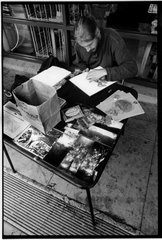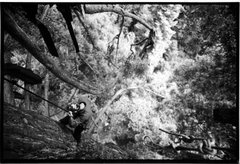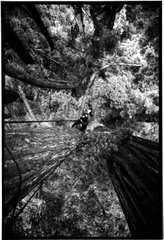
Save the Oaks!
Berkeley Treesitters Inspire the Imaginations of Bay Area Residents
By Karen Pickett
--------------------------------------------------------------------------------
It was just after 6 a.m. and still dark when the call came.
“They’re raiding the grove! The cops are here with a front-end loader, and they’re taking people’s stuff! Call the media, and get here as soon as you can!”
The call came from a grove of trees where six treesitters have taken up residence. Ground support was getting a pre-dawn visit from authorities. Was this deep in the forest in an old-growth grove? Not exactly…. These treesitters look out over the teeming Berkeley-Oakland-San Francisco urban area, the Golden Gate bridge in their view. But many of the issues and sound bites we feed the media are the same as for those treesits in the moss-draped branches of an old-growth forest. We are always dealing with last remnants, biologically. This case is no exception.
This grove isn’t habitat for any large predators except Homo sapiens anymore, but the oak woodland ecosystem has become increasingly rare, since most are in areas ripe for the same galloping development that has taken over California’s canyons and valleys. Any grove like this one, with trees up to 200 years old, also becomes an important genetic resource, as Sudden Oak Death Syndrome ravages many oak woodland areas not already cut down for urban sprawl. Oak woodlands have become rare enough that Berkeley protects it under its Coast Live Oak Moratorium, making it illegal to cut a mature oak tree measuring more than six inches in diameter. But this oak grove is on University of California-Berkeley (UCB) land. Because UCB operates essentially as a country within a city, it gets away with refusing to comply with city law.
UCB wants to level the grove for an expanded sports training facility and more parking. Since UCB went public with its plan, it has been opposed by students, the neighborhood association above the stadium, the California Oak Foundation, the California Native Plant Society, most residents of Berkeley and Bay Area environmentalists.
Three lawsuits were filed shortly after UCB went public with its decision. A fourth lawsuit was recently filed by a group calling itself Save Tightwad Hill!, on behalf of the hundreds of people who watch football games for free from a vantage point above the stadium proposed for expansion. The other three lawsuits, however, have a solid environmental foundation, including the fact that the stadium and the grove sit next to the major and active Hayward earthquake fault. The judge granted those lawsuits a preliminary injunction on January 29, barring UCB from taking action that would change the physical environment of the project site until the lawsuits are heard in court. This means that UCB cannot cut down the trees. Whether it can make other changes that would keep protesters off the site and whether it will appeal the injunction will become known soon. But in any event, it is a huge victory, and there is no doubt our momentum, visibility and public support were garnered by those arboreal crusties.
The treesit was spearheaded in December by Zachary Running Wolf (a Native American man who ran for mayor in the last election), a UCB student, an urban ecologist and a couple of veterans of northern California’s timber wars who provided invaluable ’round-the-clock ground support. Three people took ropes, platforms and rain gear up the trees at about 3 a.m. on December 2, hours before about 72,000 people would stream by the grove and into the stadium for UCB’s “big game” with Stanford University.
The inevitable raid came in the pre-dawn hours of January 12, more than a month into the treesit action. People converged in response to a call for an emergency rally at the grove. When the cops didn’t immediately come back with machinery to extract the treesitters, we marched onto the UCB campus from the grove, taking the street en route to the chancellor’s office. Police barricaded its doors from the raucous crowd, which included a contingent of UCB students demanding to see their chancellor. The raid and subsequent rally only strengthened and enlarged the coalition challenging UCB’s plans to level the grove. The treesitters who climbed the trees on December 2, brought a new dimension to the ongoing campaign to spare the oaks from UCB’s axe.
Since the treesits went up, the grove has been the site of concerts featuring musician Country Joe McDonald and ’60s icon Wavy Gravy, as well as a spiral dance, which brought out the pagan community. A treesit was orchestrated by a 71-year-old former mayor and UCB alumna, an 86-year-old Berkeley city councilwoman and 90-year-old legendary conservationist Sylvia McLaughlin. The women charmingly announced that they were bringing nearly 250 years of experience to the plywood platform. As the cameras rolled, the venerable ladies climbed a ladder into an oak and held a press conference, bullhorn in hand.
Though bordered by a busy street and the UCB stadium, the grove of about 50 trees has become a mini-basecamp and direct action site. The treesits have grown to six platforms, complete with traverse lines and a tarped area for support people, who maintain a constant presence. The grove has also been a magnet for curious visitors, including international tourists, classes of middle school kids, people with babies in strollers, dogwalkers and other passers-by. Most of these people have never seen a treesit up close. In fact, this iconic action may do more to familiarize people with the phenomenon of treesitting than famous actions by people like Julia Butterfly Hill (who has stopped by to strategize with people and offer support). Accessibility is everything here.
Coast Live Oak (Quercus agrifolia) is a beleaguered species, but oak woodlands like this one provide essential habitat that can support a whole network of other plants and animals. As with coral reefs or wetlands, the level to which these woodlands are intact and functional is everything. Just as saltgrass reeds do not constitute wetlands, the individual oaks scattered around do not an oak woodland make. This ecosystem has particular value in the Berkeley lowlands, where it has all but disappeared.
The issues are myriad; seismic safety, urban density and aesthetics. But the biological issues, while not paramount in the court challenges, are the ones that resonate universally. Those who visit the grove are enraptured by the treesitters’ stories of the nocturnal trotting of a fox they have come to know. A UCB professor who spoke at a press conference this week waxed poetic about something not immediately apparent in this small grove—the cameo ecosystem the trees hold together forms a linchpin corridor connecting wildscapes that start in the hills above UCB’s land to the remarkable park system of the East Bay and the open space watershed lands. There are mountain lion sightings in these wildlands, and this humble grove is a connecting puzzle piece. It has helped many urbanites realize the importance of these oases; it’s like turning over a rock in your driveway and finding little squirmies and tunnels in the soil. Oh yeah, others live here.
The repercussions of this campaign go beyond the grove, especially reaching those stepping through the door to direct action strategies and individual action. We are not so much honing the skills of climbers who will go on to other forest campaigns as bringing people to a tactic not previously in their sphere, creating community among an interesting and diverse coalition of people, and rekindling activism on the college campus.
For more information, contact Save the Oaks, infosaveoaks.com; www.saveoaks.com.
Karen Pickett is a longtime Earth First!er whose goal in life is to keep as many trees as possible vertical.




No comments:
Post a Comment